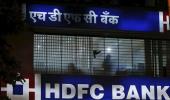Since March 31, 2022, the PSBs' market cap has risen 43.7 per cent, from Rs. 7.29 trillion to Rs. 10.47 trillion.
It's time for the government, the majority owner of public sector banks, to reap the benefit of the rally in bank stocks, recommends Tamal Bandyopadhyay.

On June 19, Bank of Baroda became the second government-owned bank to cross Rs 1 trillion market capitalisation after its share price rose a little over 3 per cent to Rs 194.22.
The other government-owned bank with a market cap upwards of a trillion is the country's largest lender, State Bank of India.
Market cap is the value of a company's all outstanding shares and refers to its worth as determined by the stock market.
Last fortnight, the BoB share closed at Rs 208.90 and its market cap touched Rs 1.08 trillion. SBI's market cap was five times bigger -- close to Rs 5.3 trillion.
No other public-sector bank (PSB) has a market cap of Rs 1 trillion, but of the 12 PSBs, three others had at least Rs 50,000 crore (Rs 500 million) worth of market cap each: Punjab National Bank (Rs 66,529 crore/Rs 665.29 million), Canara Bank (Rs 60,510 crore/Rs 605.10 million) and Union Bank of India (Rs 54,685 crore/Rs 546.85 million).
The sixth PSB, which had a market cap of close to Rs 50,000 crore, is Indian Overseas Bank.
Overall, PSBs had a Rs 10.47 trillion market cap. This is far lower than the Rs. 26.55 trillion market cap of private banks. HDFC Bank Ltd alone (not the merged entity) had a market cap of Rs 9.29 trillion.
Another four private banks in the trillion market cap club are ICICI Bank Ltd (Rs 6.63 trillion), Kotak Mahindra Bank Ltd (Rs 3.68 trillion), Axis Bank Ltd (Rs 3.01 trillion) and IndusInd Bank Ltd (Rs 1.05 trillion).
But the fact remains that PSBs have never had such a good run on the market. In fact, the entire banking sector is shining.
Since March 31, 2022, the PSBs' market cap has risen 43.7 per cent, from Rs 7.29 trillion to Rs 10.47 trillion.
In the same period, private banks' market cap rose by less than half of that: 21.7 per cent, from Rs 21.82 trillion to Rs 26.55 trillion.
During this period, benchmark indices such as Sensex and Nifty have risen 11.46 and 10.69 per cent, respectively, but the Nifty Bank index has risen 23.5 per cent.
The rise of Nifty PSU Bank index has been even more spectacular, 63.6 per cent, almost two-and-a-half times the rise in the Nifty Private Bank index.
There are reasons for the euphoria. The collective net profits of PSBs in FY2023 have been Rs 1.05 trillion, and quite a few of them, including SBI, have reported the highest-ever net profit last year.
SBI's net profit was Rs 50,232 crore (Rs 502.32 million), the highest among all listed banks.
BoB's net profit in FY2023 rose 94 per cent to Rs. 14,110 crore (Rs 141.10 million). On a lower base, Bank of Maharashtra posted a 126 per cent rise in net profit and Uco Bank doubled its.
The good news doesn't end here. All PSBs have shown a drop in their gross and net bad loans -- both as a percentage of loans as well as in absolute terms.
Isn't this, then, the time for the government -- the majority owner in PSBs -- to reap the benefit of the bull run and bring its ownership down?
Government ownership is the least in SBI -- 57.49 per cent. In the BoB, it owns 63.97 per cent.
Of the 10 other PSB, the government holds over 90 per cent stake in five, the highest being in Punjab & Sind Bank (98.25 per cent).
This bank was the last PSB to be listed, in December 2010, after United Bank of India, which had made its maiden public issue in March 2010.
While UBI, along with Oriental Bank of Commerce, have been merged with Punjab National Bank, the Punjab & Sind Bank remains an independent entity.
The government holding is less than 80 per cent in only three banks: Indian Bank, Punjab National Bank and Canara Bank.
The government has injected close to Rs. 3.12 trillion over 10 years, between 2010 and 2019, in PSBs. It has since injected around Rs 22,000 crore (Rs 220 million) more. What has it earned on this massive investment?
The Economic Survey 2019-2020 has analysed the overall government investments in PSBs and returns earned.
Going by the Survey, at least Rs 4.3 trillion worth of taxpayers' money is invested as the government's equity is PSBs.
In 2019, every rupee of taxpayer money invested in PSBs, on average, lost 23 paise.
In contrast, every rupee invested in the new private banks -- those licensed after the 1991 economic liberalisation -- gained 9.6 paise on average.
The notional opportunity cost loss is, therefore, 32.6 paise (23 paise plus 9.6 paise) for every rupee invested in PSBs.
For an investment of Rs 4.3 trillion, the amount is Rs 1.41 trillion.
The tables have now turned. The market is happy with the performance of PSBs. Shouldn't the government strike while the iron is hot?
It's not easy though to convince investors of large-scale divestments.
I am not talking about the privatisation of PSBs. Even if the government continues to own at least 51 per cent in these banks, these institutes can improve their performance, and the buyers will make a beeline only when the government gives up administrative control.
The PSBs are subjected to dual control -- by the Reserve Bank of India and the Government of India.
The RBI is the regulator, but the government calls the shots. In other words, the regulations are not ownership neutral.
This is the crux of the problem. The Narasimham Committee on banking reforms in 1991 described it as a virus and asked for a vaccine, but nothing has changed.
To excite investors, the government must give up the power to appoint the directors and fix the compensation package of banks' bosses.
Except for the shareholders' directors, all other directors are appointed by the government under Section 9 of the Banking Companies (Acquisition and Transfer of Undertakings) Act, 1970 and 1980.
This section also deals with the remuneration of the executives.
The government doesn't need to amend the Act. This section can be amended through a notification. Once this is done, PSB stocks will not look back.
Pumping capital into banks is not unique to India, but not looking for returns is. How does it compare with other markets?
The US Treasury's Troubled Asset Relief Program (TARP), set up to tackle the aftermath of the 2008 financial markets crisis, had planned to spend $700 billion.
It didn't end up paying this much, but the broader bailout programme, including separate rescue packages for Fannie Mae and Freddie Mac, created by the US Congress to play a critical role in the housing finance system, was to the tune of $634 billion.
Going by Bailout Tracker, a newsletter published by ProPublica, an independent, non-profit newsroom that traces the return of every taxpayer dollar that went into the bailout, the US government has made a profit of over $100 billion from TRAP so far.
The Government of India, too, can make money if it wants to.
Feature Presentation: Aslam Hunani/Rediff.com











